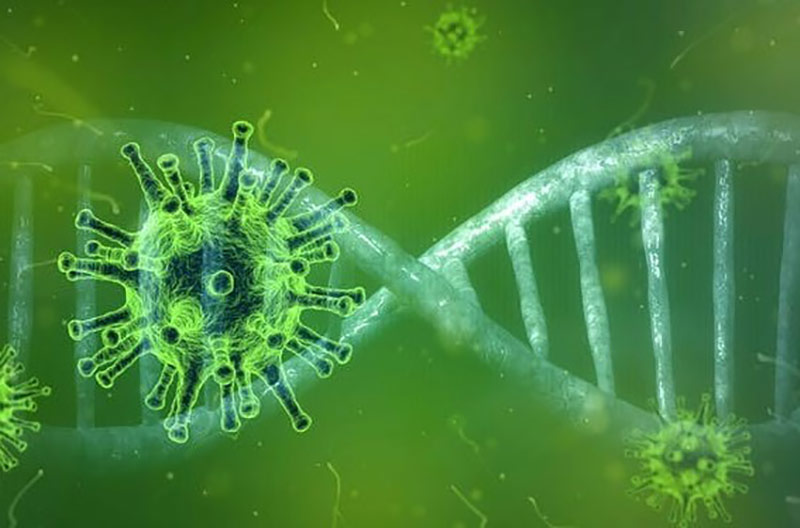Omicron, the first COVID-19 variant to have been upgraded to a variant of concern by the World Health Organization in a matter of days came on the radar of the Lancet Laboratories in South Africa on Nov. 8, although it is suspected to have been circulating earlier.
Due to their excellent genomic surveillance system, the South African health authorities reported the cases of this variant very quickly. Unlike other variants, Omicron can be detected using a reliable PCR test without requiring whole-genome sequencing, which has allowed rapid monitoring of its spread.
By Nov. 23, 1,100 cases of the variant (73 per cent of all the positive cases) had been detected in the Gauteng province of South Africa, up from 10 recorded in early November. As of Dec. 3, Omicron had officially surpassed the Delta variant in South Africa.
The effective reproduction number (the number of people infected by a single infected individual) for Omicron is estimated to be above six, while the effective reproduction number for Delta was estimated around five and the reproduction number for a very contagious disease like chickenpox is nine.
Where has Omicron spread?
The Omicron variant is confirmed in all continents but Antarctica. The reported cases outside South Africa seem to be mainly travel-related at this point and are mostly among vaccinated people. However, community spread is already feared.
Projections by many countries predict that Omicron cases will soon start to overtake Delta cases. Ontario’s chief medical officer of health reported on Dec. 12 that Omicron cases account for 10 per cent of all positive cases in the province, a confirmation that Omicron is highly transmissible even with the current reduced level of social activities (75 per cent of pre-pandemic levels).
How is Omicron different from the other variants?
Variants emerge through changes or errors, called mutations, in the sequence of the virus’s genome, which is the virus’s set of genetic instructions.
The Omicron variant has significantly more mutations than other variants in its S gene — the gene that encodes the virus’s spike protein, which is the key that provides the virus with access to our cells. Omicron has accumulated 50 mutations, including 32 mutations in the S gene. By contrast, the Alpha variant has nine mutations in its S gene, and Delta has between nine and 13 mutations.
Both are more transmissible than the original variant, 50 per cent and 100 per cent more transmissible, respectively, and both challenged vaccine-induced protection to some degree.
It is too early to tell what to make of the Omicron variant. Because proteins are made of chains of amino acids, mutations in the S gene will lead to amino acid substitutions that cause changes in the spike protein. The number of amino acid substitutions in Omicron’s spike protein, and their overlap with those seen in the other variants of concern and variants of interest, make this variant’s spike protein look supercharged.
The Omicron spike protein carries six unique amino acid substitutions that have not been observed in the other VOC, seven substitutions that are seen in one or more VOC, three substitutions that occur in all the current VOC, and the remaining substitutions are seen at a much lower frequency in the other variants. The three amino acid substitutions common to all the VOC are associated with immune escape and increased transmissibility and infection in VOC.
Is Omicron a ‘supervariant’?
As a scientist, I have a hard time wrapping my head around this variant. How did the Omicron spike protein accumulate 32 amino acid substitutions in what seems to be a very short time, and accommodate that many substitutions in a single protein? Has this protein become the perfect key to access our cells, and at the same time camouflage itself from the antibodies? Does Omicron cause more serious illness?
When and how Omicron evolved will not be easy to answer, but certainly, the mutations acquired by this variant have scientists scratching their heads.
The sheer number of amino acid substitutions in the spike protein is notable. Proteins are quite flexible in their ability to accommodate these substitutions, enabling them to become more efficient. But this often comes at a hefty cost to the microbe (in this case the virus) because the substitutions require energy and resources.
First, for each useful mutation, a compensating mutation must also occur in the gene to ensure the protein structure remains intact.
Second, the existence of such a large number of mutations in the S gene would require changes to the virus’s replicating machinery to allow so many errors to occur. However, altering this machinery could spell trouble for virus replication.
Lastly, the virus relies on the host’s resources to build its proteins, such as the host’s special RNA molecules (transfer RNA) and amino acids. These resources, and potentially others, may not meet the demands of the virus and may lead to its malfunction. That is, the mutated virus may run into a supply-and-demand issue.
In short, such a “super-mutated” S gene is very likely to take a toll on the overall fitness of the virus; something else has to be less efficient in order to accommodate the production of a super-mutated S gene. This loss in fitness is normal in the microbial world. For example, antimicrobial resistance in bacteria is driven by the use of antibiotics. However, in their absence, bacteria often lose this trait as it is energetically costly.
This suggests the Omicron variant may be more transmissible (as the current real-world data show) than Delta, but it may cause less serious illness. The data coming from South Africa and the cases identified around the world suggest that Omicron cases have not been associated with severe illness and death.
Will vaccines or prior infection protect against Omicron?
The current vaccines were designed to protect against COVID-19 disease, that is, to protect against hospitalization and death. However, they performed better, reducing infections by as much as 80 per cent (for mRNA vaccines) and curbed transmission.
Whether the Omicron variant can evade immunity, induced by either natural infection or vaccine, is unknown. However, a study that has not yet been peer reviewed shows that re-infections with Omicron are much higher than those recorded during the Beta and Delta surges in South Africa. This report suggests that the immunity gained due to prior infections with Beta or Delta variant may not prevent infection by Omicron. This finding could explain the rapid rise of Omicron cases in South Africa, where a large portion of the population got infected in the Alpha, Beta and Delta surges.
No conclusion could be drawn in this study about the protection of vaccine-induced immunity against Omicron due to insufficient data; the vaccination rate in South Africa is only about 25 per cent. Breakthrough Omicron-related cases occurring around the world suggest that Omicron may challenge the vaccines in terms of infection.
Note that an infection can be asymptomatic or mild. The vaccines are very likely to protect against severe COVID-19 disease, as recent reports (not yet peer reviewed) from South Africa indicate.
In light of many reports that vaccine-induced (or natural infection) neutralizing antibodies wane with time, many countries, including Canada, are rushing to administer booster shots and increase vaccination coverage to protect their population against a possible resurgence. Booster shots were shown to protect against infection and the severity of the disease in clinical studies and real-world data. A recent report by Pfizer indicated that the booster shot can change the Omicron transmission trajectory.
What’s likely for Omicron in the near future?
Many laboratories around the world are assessing where Omicron stands regarding its transmissibility, virulence, the severity of the disease it may cause and its ability to evade vaccine-induced protection. So, for now, it is a waiting game.
Here in Canada we should continue to increase the vaccination coverage to 90 per cent and above for the eligible population. Vaccines work! The approval of vaccines for children ages five to 11 will undoubtedly increase further vaccine coverage and change the Omicron transmission trajectory.
At the same time, we should continue with public health measures: face masks (real-world data show that they prevent spread of the virus by 53 per cent), physical distance (COVID-19 is an airborne disease), hand hygiene and avoidance of large gatherings, especially indoors.
Finally, and equally important, the emergence of the Omicron variant reminds us, one more time, how critical it is to assist developing countries with their vaccination campaigns. The virus will continue to challenge the progress that developed countries make through vaccination for as long as the virus finds fertile ground to evolve anywhere in the world.![]()
![]()
Read more: Coronavirus
















Tyee Commenting Guidelines
Comments that violate guidelines risk being deleted, and violations may result in a temporary or permanent user ban. Maintain the spirit of good conversation to stay in the discussion.
*Please note The Tyee is not a forum for spreading misinformation about COVID-19, denying its existence or minimizing its risk to public health.
Do:
Do not: